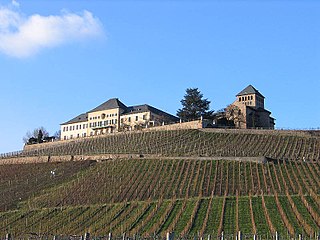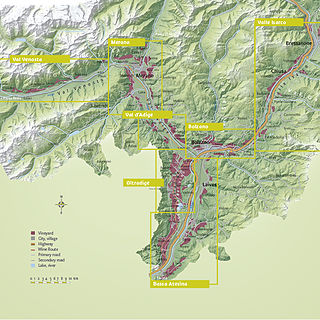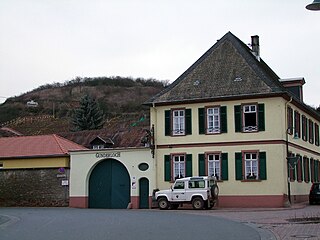Related Research Articles

The Zweigelt, also known as Rotburger, is a new Austrian grape created in 1922 by Friedrich Zweigelt (1888–1964), who later became Director of the Federal Institute and Experimental Station of Viticulture, Fruit Production and Horticulture (1938–1945). It comprises a crossing between St. Laurent and Blaufränkisch.

Blaufränkisch is a dark-skinned variety of grape used for red wine. Blaufränkisch, which is a late-ripening variety, produces red wines which are typically rich in tannin and may exhibit a pronounced spicy character.

Klosterneuburg is a town in Tulln District in the Austrian state of Lower Austria. It has a population of about 27,500. The Klosterneuburg Monastery, which was established in 1114 and soon after given to the Augustinians, is of particular historical importance.

Scheurebe or Sämling 88 is a white wine grape variety. It is primarily grown in Germany and Austria, where it often is called Sämling 88, and some parts of the New World. Scheurebe wines are highly aromatic, and the variety is often used for sweet wines, although dry Scheurebe wines have become more common in Germany.

Hermann Müller, was a Swiss botanist, plant physiologist, oenologist and grape breeder. He called himself Müller-Thurgau, taking the name of his home canton.

St. Laurent is a highly aromatic dark-skinned wine grape variety. Its origins shrouded in mystery, St. Laurent is believed to have resulted from a crossing of Pinot noir with an unknown second parent. However, current DNA research done at HBLAWO Klosterneuberg in Austria by Dr. Ferdinand Regner has now confirmed the genetic link of St. Laurent to Pinot Noir. A link to a second parent was not able to be confirmed in this research, which led Dr. Regner to conclude that St. Laurent is either a 'selfing' or seedling of Pinot Noir, or it is the result of hybridization with an as yet unidentified second parent. This work confirms that St. Laurent is the direct genetic offspring of Pinot Noir.

Austrian wines are mostly dry white wines, though some sweeter white wines are also produced. About 30% of the wines are red, made from Blaufränkisch, Pinot noir and locally bred varieties such as Zweigelt. Four thousand years of winemaking history counted for little after the "antifreeze scandal" of 1985, when it was revealed that some wine brokers had been adulterating their wines with diethylene glycol. The scandal destroyed the market for Austrian wine and compelled Austria to tackle low standards of bulk wine production, and reposition itself as a producer of quality wines. The country is also home to Riedel, makers of some of the most expensive wine glasses in the world. Some of the best producers of Austria include Weingut Bründlmayer, Weingut F.X. Pichler and Weingut Franz Hirtzberger, Weingut Hutter, Weingut Eigl and Wellanschitz.
Blauburger is a red wine grape variety that is grown a little in Austria, Czech Republic and Hungary. It should not be confused with Blauburgunder, which is an Austrian synonym for Pinot noir.

Rheingau is one of 13 designated German wine regions (Weinbaugebiete) producing quality wines . It was named after the traditional region of Rheingau, the wine region is situated in the state of Hesse, where it constitutes part of the Rheingau-Taunus-Kreis administrative district. Although, making up only 3 percent of the total German vineyard area, Rheingau has been the source of many historically important innovations in German wine making, and contains many wine producers of international reputation, such as Schloss Johannisberg. Rheingau, with 3,125 hectares of vineyards in 2016, also boasts a higher proportion of Riesling (77.7%) than any other German wine-growing region, with Spätburgunder making up most of the rest (12.2%), followed by Müller-Thurgau.
Goldburger is a white Austrian wine grape grown primarily in the Burgenland region. The grape is a crossing of Orangetraube and Welschriesling and was created in 1922 by Fritz Zweigelt at the Höhere Bundeslehranstalt und Bundesamt für Wein- und Obstbau (HBLAuBA) in Klosterneuburg.
Roesler is a red Austrian wine grape developed in 1970 by Dr. Gertraud Mayer at Höhere Bundeslehranstalt und das Bundesamt für Wein- und Obstbau in Klosterneuburg, Austria. It is the result of a crossing Zweigelt x. It is named after the former director of Austria's oldest viticultural college, Leonard Roesler (1839–1910), who was a German-Austrian chemist and oenologist. The variety is deep in colour and with abundant extract. It is frost resistant and can withstand temperatures as low as -25ºC (-13ºF). It is also resistant to mildew.

South Tyrol is an autonomous province located in north-east Italy producing wine. This Austro-Italian wine region is noted for the distinct Austrian influences on the wine industry due to the region's long history under the rule of Austria-Hungary and Holy Roman Empires.

Weingut Gunderloch is a German wine grower and producer based in Nackenheim, in the Rheinhessen wine region, Germany.

Kullabergs vingård is a vineyard located in Höganäs Municipality, Skåne County, Sweden Kullabergs vingård produces wine, cider and distillates from estate grown grapes and fruit. The property is a part of the Balderup estate. Winemaker is K Felix G Åhrberg, oenologist from Klosterneuburg in Austria. The oldest field is 2 ha big, planted in 2006, containing the varieties Solaris, Regent and Rondo. In 2017, 7 ha were planted with Solaris and the new varieties Souvignier gris, Muscaris and Donauriesling. During 2019 a further 4 ha were planted with blue varieties Pinot Nova and Cabernet Noir. The vineyard is entirely planted with fungi resistant so-called PIWI varieties allowing sustainable viticulture without pesticides and herbicides. In Sweden, the products are sold through Systembolaget.

The Lower Moselle is the name given to the lower reaches of the Moselle river - just under 100 kilometres long - in Germany between Pünderich and the Moselle's confluence with the Rhine at Koblenz. The Lower Moselle landscape differs from that of the Middle and Upper Moselle, much of it forming a narrower valley with high and steep sides in places. On the cut banks of the river that are oriented towards the south and west, vineyards are managed, often on the tiniest, terraced strips of land on steep hillslopes.

Eduard Lucas was a German pomologist.
Norbert J. Becker was a German agricultural scientist, specializing in the area of vine breeding and viticulture.

Robert Sedlaczek is an Austrian journalist, Germanist and non-fiction author. He is best known for his works on aspects of the German language. In addition, he writes books and articles on cultural history topics. In his book Die Tante Jolesch und ihre Zeit. Eine Recherche he traced the history of the industrial family of the same name as well as the lawyer, Hugo Sperber. These people are characters in Friedrich Torberg's book Die Tante Jolesch.
Georg Scheu, was a German botanist, plant physiologist, oenologist and grape breeder.
References
- ↑ "Erfolgsgeschichte mit dunklen Flecken: 'dok.film: Zweigelt – Wein und Wahrheit' präsentiert". (Memento of the original film of 4 March 2016 in the Internet Archive) In: ORF 2011, accessed on 20 November 2014.
- ↑ Personnel file Dr. Friedrich Zweigelt, questionnaire of 23 July 1941, BArch R 3601/6340 Sheet 14.
- ↑ Friedrich Zweigelt, curriculum vitae of 9 January 1912 (personnel file, Austrian Ministry of Agriculture, ÖMinLW). See also Friedrich Zweigelt, Von den Höhepunkten meines Lebens – Werk und Freude, in: Zeitschrift für angewandte Entomologie 54 (1964), pp. 13-21.
- ↑ Wilhelm Zwölfer, Laudatio, in: Zeitschrift für angewandte Entomologie Vol. 54 (1964), pp. 11-13.
- ↑ For more information on the eventful history of the oldest school of viticulture in the German speaking countries, cf. "Programm und Jahresbericht der k.k. höheren Lehranstalt für Wein- und Obstbau in Klosterneuburg, zugleich Jubiläumsschrift anläßlich ihres 50jährigen Bestehens" (Vienna 1910), "Denkschrift zur 70jährigen Bestandesfeier der Höheren Bundes-Lehranstalt und Bundesversuchsstation für Wein-, Obst- und Gartenbau in Klosterneuburg" (Klosterneuburg 1939), and Emil Planck, "90 Jahre Höhere Bundes-Lehranstalt und Versuchsanstalt für Wein-, Obst- und Gartenbau Klosterneuburg. Jahresbericht 1945-50. Fünf Jahre Wiederaufbau" (Klosterneuburg 1950).
- ↑ Fritz Zweigelt, Der gegenwärtige Stand der Klosterneuburger Züchtungen (autumn 1924), special edition of the "Allgemeine Wein-Zeitung" 41 (1924) and 42 (1925). The aims of the cultivation were to achieve early ripeness and quality. Blütefestigkeit, Fäulnisfestigkeit, Ertrag, Qualität, Reblausfestigkeit oder Peronosporafestigkeit; Paul Steingruber, Dreißig Jahre Rebenzüchtung an der Höheren Bundes-Lehr- und Versuchsanstalt für Wein-, Obst- und Gartenbau in Klosterneuburg, in: Mitteilungen 1 (1951), p. 45, p. 89 and p. 135.
- 1 2 Ordinance of the Federal Minister of Agriculture and Forestry of 20 September 1978 (Federal Law Gazette No. 517/1978)
- ↑ Franz Wobisch, Dr. Zweigelt – zu seinem 70. Geburtstag, in: Österreichische Weinzeitung 13 (1958), Issue 1.
- ↑ Cf. the report made to the International Wine and Viticulture Congress in Conegliano, probably written by Zweigelt himself, in: Allgemeine Wein-Zeitung 44 (1927), pp. 188–190.
- ↑ Friedrich Zweigelt, Die Ertragshybriden und ihre Bedeutung für den europäischen Weinbau, in: Internationale Landwirtschaftliche Rundschau. Part I: Agrikulturwissenschaftliche Monatsschrift, Rome, March 1930, No. 3. This also contains a concise summary of the cultivation of direct producers in all European wine growing countries. Zweigelt published a highly informative report on "Prüfung von Hybridenweinen in Klosterneuburg" in Das Weinland 3 (1932), pp. 19-21. Similar and comprehensive treatments may also be found in Das Weinland 5 (1933), pp. 29-33, pp. 68-71, p. 103, pp. 213-215, pp. 250-254, pp. 291-295 and pp. 367-372.
- ↑ Albert Stummer/Friedrich Zweigelt, Die Direktträger, Vienna 1929. The book received several plaudits, including a prize awarded by the International Wine Office (Paris). See Das Weinland 5 (1933), p. 10.
- ↑ Senior civil servant Dr. Fritz Zweigelt (undated self-disclosure, presumably 1938), Volksgericht file Vienna City and State Archive Vg 2e Vr 3281/45 Supplement 1.
- ↑ Zweigelt himself on the Austrians in general: Dem Führer Dank und Gelöbnis, in: Das Weinland 11 (1939), p. 109. On himself: "Borderers know more about the worries and dangers of foreign infiltration. After all, they have experienced the humiliation of deprivation of privileges, mistrust and constant betrayal of their national rights without interruption. This makes them tougher and more receptive than others who live in a closed and landlocked state and have never had to fight for their national rights." Fritz Zweigelt, In celebration of 13 March 1941, typed statement in: Volksgericht file Vg 2e Vr 3281/45, Sheets 147-169, citation Sheets 148 ff.
- ↑ Interview/written record, Vienna Police Department/State Police Group XXVI, 6 July 1945, Volksgericht file Vienna City and State Archive Vg 2e Vr 3281/45. Sheets 21-22.
- ↑ Friedrich Zweigelt, Zu neuer Arbeit, in: Der deutsche Weinbau 17 (1938), pp. 391-393.
- ↑ A decree issued by the Reich Ministry of Food and Agriculture on 28 May 1941 made Zweigelt the "Permanent Head" of the Testing and Research Institute with retrospective effect from 1 April 1941. (Personnel file, Austrian Ministry of Agriculture, ÖMinLW Sheet 40). Appointment to the position of Director followed on 27 May 1942. Ibid. Sheet 61.
- ↑ Heinrich Konlechner, Dr. Fritz Zweigelt. 30 Jahre an der Klosterneuburger Lehranstalt tätig, Das Weinland 14 (1942), p. 41.
- 1 2 Volksgericht file Vienna City and State Archive Vg 2e Vr 3281/45.
- ↑ Cf. Daniel Deckers, Im Zeichen des Traubenadlers. Eine Geschichte des deutschen Wein, Mainz 2010/2. Frankfurt edition 2018, pp. 109-147. For Austria, see Ernst Langthaler, Weinbau im Nationalsozialismus, in: Willi Klinger/Karl Vocelka (editors), Wine in Austria. The History, Vienna 2019, pp. 206-212.
- ↑ Archive of the Federal Institute of Viticulture and Fruit Production in Klosterneuburg, Dr. Fritz Zweigelt – personal papers.
- ↑ Cf. correspondence between Zweigelt and the Reichsnährstand in Berlin. Archive of the Federal Institute of Viticulture and Fruit Production in Klosterneuburg, Dr. Fritz Zweigelt – personal papers.
- ↑ Verbal information provided by Thomas Leithner, Langenlois, great-grandson.
- ↑ Personnel file, Austrian Ministry of Agriculture, ÖMinLW.
- ↑ For information on Roman K. Scholz, Klosterneuburg and the Austrian Resistance cf. in particular: Das Geheimnis der Erlösung als Erinnerung, Herausgegeben aus Anlass der Enthüllung einer Gedenktafel für Roman Karl Scholz and "Österreichische Freiheitsbewegung", Klosterburg, year of publication not stated. Cf. also a book written by Scholz's pupil Grete Huber-Gergasevicis, Roman Karl Scholz, Klosterneuburg 2010. This work was very much influenced by her personal acquaintance with Scholz.
- ↑ Josef Bauer was taken into custody in June 1940, just after Scholz's own arrest. A copy (dated 25 September 1945) of the minutes of a teachers' staff meeting held on 28 August 1940 has been retained in the Documentary Archive of the Austrian Resistance (DÖW) in Vienna together with various other files relating to the Roman K. Scholz case.
- ↑ Neither the Volksgericht file Vienna City and State Archive Vg 2e Vr 3281/45, nor the act of clemency held in the records of the Austrian Federal Ministry of Justice (ÖStA BMJ, Section IV, VI-d, 31.212-49) nor indeed Zweigelt's personal file at the Austrian Ministry of Agriculture contains any indication that Zweigelt was pursued any further because of these events.
- ↑ ÖStA Federal Ministry of Justice, BMJ, Section IV, VI-d, 31.212-49. For a portrayal of Renner as the "personification of typically Austrian behaviour", cf. Oliver Rathkolb, Die paradoxe Republik. Österreich 1945 bis 2005, Vienna 2005, pp. 157-163.
- ↑ Municipal Authority Office for the 19th District of Vienna, certification of 18 February 1948, personnel file, Austrian Ministry of Agriculture, ÖMinLW.
- ↑ Viktor Richter, Prof. Dr. Fritz Zweigelt (1888-1964) +, in: Zeitschrift für angewandte Entomologie, Vol. 55 (1964-1965), pp. 100-101. Zweigelt's last recorded public utterance is a speech of thanks he gave in 1963 after being awarded the Karl Escherich Medal. Zweigelt, Von den Höhepunkten meines Lebens – Werk und Freude, in: Zeitschrift für angewandte Entomologie 54 (1964), pp. 13-21.
- ↑ Paul Steingruber/Leopold Müllner, Dreißig Jahre Rebenzüchtung III, in: Mitteilungen der Höheren Bundeslehr- und Versuchsanstalten für Wein-, Obst- und Gartenbau Klosterneuburg und für Bienenkunde Wien-Grinzing 1 (1951), pp. 135-138.
- ↑ Lenz Moser, from 1960: Zweigelt-Kreuzungen im Verkauf, in: Österreichische Weinzeitung 13 (1958), Issue 2, p. 11.
- ↑ Ordinance of the Federal Minister of Agriculture and Forestry of 26 November 1971 (Federal Law Gazette No. 2/1972).
- ↑ Ordinance of the Federal Minister of Agriculture and Forestry of 20 September 1978 (Federal Law Gazette No. 517/1978).
- ↑ Verbal explanation provided by Josef Weiss, Director of the Federal Institute of Viticulture and Fruit Production in Klosterneuburg for many years.
- ↑ NS-Vergangenheit: Zweigelt soll umbenannt werden , ORF, 10 December 2018, retrieved on 24 April 2020.